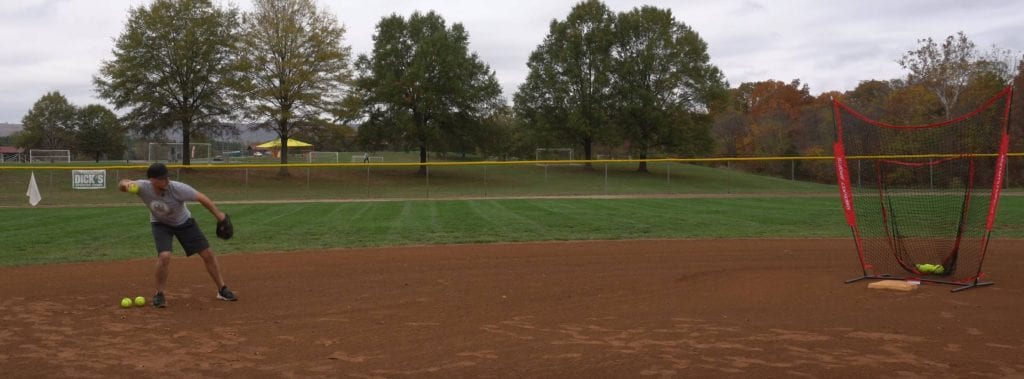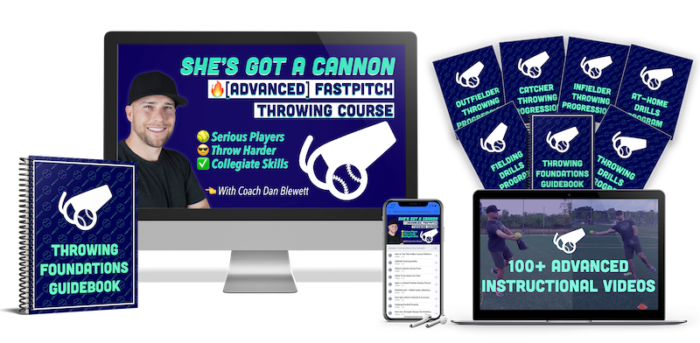*This article may contain product links which pay me a small commission if you make a purchase. Learn more.
In this article, you’ll learn softball throwing drills that you can use even if you’re already an advanced fastpitch player. High level players have a lot of advanced techniques that they need to learn to play in college.
And if you’re a beginner, don’t be afraid of giving them a shot too. Advanced softball throwing mechanics can be developed over time by any player with dedication and focus to perfecting the details.
Click anywhere above to jump to that section.
What Does an Elite Softball Thrower Look Like?
Hard-throwing softball players can typically throw at least in the 60s.
60 miles per hour is a great milestone that every player both can achieve, and should train to achieve.
If you don’t throw at least 60, it will be difficult to play at the collegiate level in many positions, such as third base or shortstop. These positions require long throws and quick releases with good velocity. So, building better throwing speed helps a player future-proof her career in fastpitch.
Traits of Hard-Throwing, Advanced Softball Players
What do high-level softball players have that beginners and lower-level players don’t? The first thing is a good foundation of mechanics and instruction.
A foundation of proper throwing mechanics is critical before attempting higher-level, advanced throws.
Again, I do encourage beginners and young players to try things and challenge themselves athletically. But, this should not come at the expense of focusing on basics. Young players need basics first, advanced drills second.
What Advanced Softball Throwers Have That Others Don’t
- They use their hips better than other players
- Produce power from their front side better
- Have proper joint angles at the elbow and shoulder, which is critical for advanced throws
- Throw with aggressiveness and don’t get cheated
- Have great footwork and move their feet fast
- Field balls with excellent technique, glovework and footwork
The goal is to chip away at all of the above. Then, beginners and novices can slowly inch their way to becoming hard-throwing players who are ready to take on advanced throwing drills.
Advanced Softball Throwing Drill #1: The Feed Throw

The “feed” throw is a short, quick sidearm throw used by infielders, typically the shortstop and second baseman.
To perform the feed throw, a player will stay bent over in an athletic position, essentially staying down in the position she fielded the ground ball.
Key Points in the Feed Throw
- This is a sidearm throw–going overhand is NOT an efficient or effective way to do this because of the hunched-over position.
- The player should remain folded over at the hips in a good, athletic fielding position.
- The feet will either stay planted or pivot slightly, but will NOT really move. The point is it’s a quick release.
- The elbow much pull back, behind the body–the player gets much more power from the arm and thus getting a good shoulder blade pinch helps create as much power as possible.
- The elbow joint angle will be closer to 70 degrees.
- The glove arm will just pull slightly out of the way to help the hips and torso rotate.
Don’t overcoach this throw!

This one is an athletic throw and will take practice more than anything. When a player doesn’t follow the above guidelines, it’s just an awkward throw to make in general, so the body starts to figure it out on its own.
Advanced Softball Throwing Drill #2: Throws From Low Arm Angles
Throwing over the top should always produce the highest throwing velocities and be the best choice for outfielders, catchers when they have to throw to second, or infielders who have time to make their hardest throw.
But, sidearm throws and throws from low arm angles are necessary in the following cases:
- When a player is moving through a ball on the run
- Fielding a ball when moving to the right
- Making a feed throw to a base
- When there isn’t time to come back up out of a fielding position
- Making a barehand throw while moving through the ball
When time is of the essence, there isn’t time to stand up, shuffle and throw over the top. This is why at the high-levels of softball and baseball, players are constantly moving, charging balls and throwing on the run.
This video below on advanced throwing techniques shows you how to throw from all sorts of weird arm angles.
Throwing Drills For a Strong Foundation
No matter the skill level of a player, I’ve found that these two drills below make a big difference. If you’re not sure if you’re ready for advanced throws but DO want to improve, start with these below.
And, check out my YouTube channel and my playlist on throwing basics.
Foundation Drill #1: Hop-Pause Drill For Handbreak Errors
The timing of when a softball player breaks her hands can make a huge difference in everything that comes after it.
Because the body is a chain, transferring power from the lower half all the way up to the hand and the ball, things that happen early can have a profound effect later on.
Watch the video below on hand-break timing for clarity on what good timing looks like and how it can improve softball throwing velocity.
This is a throwing drill that makes a HUGE difference for most players. Handbreak timing is a big problem, as this will impact the rest of the delivery.
Foundation Drill #2. Long Toss on a Line
I’m not an advocate for high-angle, “bomb-it-out” style long toss.
I am, however, all for players stretching it out and challenging their arms on a low line, one that could be cut by a cutoff man (cutoff woman?).
The swing-shuffle drill is one of my favorites for long toss, and it helps work on the body’s rhythm, the glove arm, lateral hip explosiveness and momentum.
It’s a great long toss drill for softball players and baseball players alike.
Watch the video below to learn it.
Long toss is cultural in baseball, but we need to help it grow in softball. The more fastpitch players are throwing the ball far and challenging themselves, the more their mechanics will improve on their own. The body is smart and will become more efficient over time.
Free Throwing Ebook & Other Resources
Get a copy of my free throwing ebook. In it, you’ll find drills, videos and tips. You’ll also get my softball throwing emails with inside tips, new content and more.
Sign up today and keep working hard on improving your throwing mechanics.
Fastpitch Players: Need More Help Throwing Harder?
I hope you enjoyed this free guide to advanced softball throwing drills and techniques.
Softball mechanics can be confusing, but my goal is always to break it down simply and make it feel easy.
If you want a straightforward, step-by-step video training course you can start immediately, check out my throwing course, She’s Got a Cannon.

The course has 100+ videos and routines you can start using today.
If you’re not sure what you need, consider setting up a free call with me.
Advanced Softball Throwing Drills FAQ
Look below for common questions and answers. And, be sure to leave a comment or question below!
How hard do college softball players throw?
Most collegiate fastpitch players throw at least in the upper-50s, with most throwing in the 60s. Throwing 70mph is rare even amongst high-level softball players. Players can gain 3-5mph per year if they work hard on their throwing mechanics, strength and conditioning and throwing arm strengthening.
What are some good softball throwing drills?
Some of the best drills are the lawnmower drill, the rocker drill and the hop-pause drill. These help players improve their arm action, throwing speed and accuracy when done consistently. It’s important to start with foundational drills that improve the basics, then move on to advanced softball throwing drills as the basics become solid.
How do I improve my throwing in softball?
Follow this step-by-step process:
1. Create a throwing routine of good throwing drills. Follow this routine every day in practice and before games.
2. Work on your mechanics at home.
3. Long toss more and challenge yourself to throw the ball farther at a low angle (not too loopy).
4. Strengthen your throwing arm with exercises for the rotator cuff, shoulder and forearms.
5. Lift weights consistently with a good strength coach to develop more overall strength.
All of these factors will help improve your throw in softball.
When should a player begin advanced softball throwing drills?
I think players of all ages should be unafraid to try new drills and advanced techniques in practice. As a coach, you should try to foster an environment of learning, helping players to explore their athleticism without fear of failure.
Is it bad to throw sidearm in softball?
It depends. Throwing sidearm is a tool used by infielders–sidearm throws are faster and easier to get off quickly depending on the situation, and throws on the run are almost always made sidearm. When hunched over in fielding position, on the run or moving to the right, sidearm throws are the best way the body figures out to make a good throw.
But, if a player’s default throw when she wants to throw really hard is sidearm, then thats often the result of throwing mechanics flaws (not always, but most of the time). So, I’d say to do some mechanics analysis and see if throwing sidearm is because of underlying mechanics flaws.
Have a Question? Leave a Comment below.
Thanks for reading and I hope to hear from you–leave a comment below.
